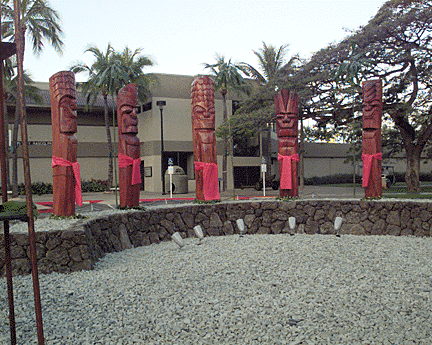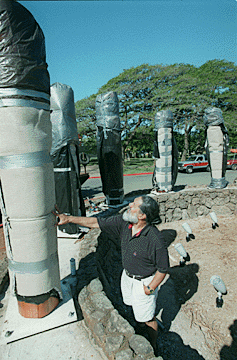


Carving a link
to the past
Undaunted by lack of funds, criticism,
By Burl Burlingame
from the local art community and government
red tape, artist Rocky Jenson toiled for four
years to create a memorial to
fallen Hawaiian warriors
Star-BulletinTHE usefulness of armies and modern weapons was not lost on King Kamehameha. He united the islands primarily by force of arms, and had he not done so, any concept of a sovereign Hawaiian nation would be moot today.
So it's fitting that the U.S. Army Museum of Hawai'i at Fort DeRussy interprets the history of military power in Hawaii, beginning with pre-contact Hawaii.
The museum is at Kalia, the gateway to Waikiki, on land presented to High Chief Kalanimoku as reward for his service during the crucial Battle of Nuuanu. Kalia was where Kamehameha stepped ashore while invading Oahu.
The U.S. Army has no national museum. Instead, it has a network of smaller museums on active-duty army posts. Partly because of its location in Waikiki, partly because of the rich history it represents and partly because of the high quality of its exhibits, the U.S. Army Museum of Hawai'i is the most-visited army museum in the United States.
This is largely due to director Thomas Fairfull, who inherited the job in the late '70s. In 1978, he approached Hawaiian master artist Rocky Ka'iouliokahikikolo'ehu Jensen with the idea of creating a kukalepa, a memorial to fallen Hawaiian warriors. Fairfull wanted a work of mythological power that tied together the past and future.

"I was thinking in terms of a plaque," recalled Fairfull. "It was Rocky's idea to create a true memorial site."Jensen was enthusiastic. He designed a landscaped theme that uses five pieces like a kind of Hawaiian Stonehenge. As an artist, Jensen knows that the space around a sculpture is as important as the work itself, and he arranged the pieces for maximum mystical oomph.
Each piece is similar, with differences. They are aspects of Kunuiakea, the Hawaiian masculine god; popularly known as "Ku," the God of War. Each headpiece represents a different face and personality of Ku. The entire site is called "Ka Lehua Halele'i," or, "the scattered lehua blossoms," an ancient phrase that equates the red petals with the blood of fallen warriors.
"It's like bringing to life the spirits of the ancestors themselves, using modern techniques on very old art," said Jensen. "This isn't decor. It's not like knocking out a tiki for a hotel lobby. The real challenge was portraying the benign, healing aspects of Ku, as well as the warlike. Warfare comes with the territory; it's what happens afterwards that counts."

But -- and there are always buts in the financially strapped museum business -- the Army museum itself took 15 years to rehabilitate and create. By the time Jensen could be contacted again about his concept, the budget for the work had vanished. The artist was given the option of backing out of the contract, or -- and there are always ors in the museum business -- the Army could provide in-kind services and space to make it easier for Jensen."It seemed insurmountable," said Fairfull, who credited garrison commander Col. David Helala with breaking the bureaucratic logjam.
Jensen's life has been devoted to the concept of honoring his ancestors through his art. He decided to bite the bullet, and ploughed ahead with the creation of the work, relying on the generosity of friends and neighbors to feed himself and his family. "A lot of aloha from my wife Lucia and the kids got us though," he said.
'Ohi'a logs, the largest Jensen has ever seen, were donated by Charles Medeiros of Honaunau and acquired by Big Island businessman John Kekua. The logs were shipped to the Maluhia building at Fort DeRussy, where the Army provided space for Jensen to work.
"And then President Clinton was coming to town and someone decided the Maluhia building had to go," laughed Jensen. Space was found at Kilauea Military Camp at Volcano. The logs, each a couple of tons, were shipped back to the Big Island, courtesy Young Bros.
The use of the workspace helped compensate Jensen for the lack of money. In the high, cold magic of Kilauea, it took Jensen nearly four years to carve the sculptures. "I learned to wear long johns and gloves," said Jensen. "It's cold up there in winter!"
Although modern tools were used, traditions were observed. The 'ohi'a chips, for example, were returned quietly to the forest. "Ancient Hawaiians were very quick to pick up modern tools," said Jensen. "The first two ancient professions to disappear were kapa makers and adze makers, because cloth and steel were superior materials."

The kukalepa was finally dedicated at a ceremony yesterday. "It's absolutely magnificent, both on the levels of creativity and scholarship," said Fairfull. "It's awesome! The average person will be struck by the caliber of the work and the hugeness of it. And for those who understand the culture, it will provide very deep emotions. We're talking win-win not just for the army and Rocky, but for the whole community."According to Jensen, the last time a Hawaiian sacred place was created was in 1808, when Kamehameha commemorated the Battle of Nuuanu. "People are just scared of tikis."
Ironically, Jensen never served in the Army. He was drafted after graduating from high school in 1962, but passed over because of a hearing problem.
He also had a growing regard for museums and the preservation work they do. "To me, Bishop Museum was like an ivory tower that held things in dark, dusty corners. Then I started to research, and I soon realized that without museums, history would not be preserved at all. We wouldn't know anything. It's an overwhelming job, and museums need all the help they can get. No matter what culture you're from, museums help focus on the positive connections between cultures, not the differences. They're in the forefront of fighting ignorance."
Other artists harassed Jensen for essentially donating his time. It wasn't professional, they said, and set a bad example. Although Jensen understands their position, the kukalepa had begun something of a holy mission for him.

"It was really an opportunity to work with aloha, to use the concept of aloha, and the community took us in and kept us alive while I worked," said Jensen. "When the creative surge strikes, you just have to go forward and endure it."Even so, it was the military that stepped in "at the 11th hour and saved the project," said Jensen, not the Hawaiian community. "A lot of Hawaiian folks were leery, figuring that we must have had some ulterior motive. They thought it was just a couple of tikis. 'Why is he doing this?' they said. 'Why doesn't he demand money?' 'Oh, no -- Rocky's carving tikis! Spooky, yeah?'"
Said Fairfull, "There's a degree of friction between the army and certain parts of the local community. Rocky and I envisioned this as a kind of bridge."
"I know artists who refuse to display their works in U.S. buildings," said Jensen. "I was very taken with the fact, though, that the army was very respectful of my work. They walked the walk. They talked the talk.
"What this is about is preserving the culture. I really believe in that phrase about those who don't know history being condemned to repeat it. I hope the Hawaiian community doesn't spend the next 200 years being this fractious. You've got to light the match to lead others down the dim path. Do that, and other torches will burn."
Click for online
calendars and events.